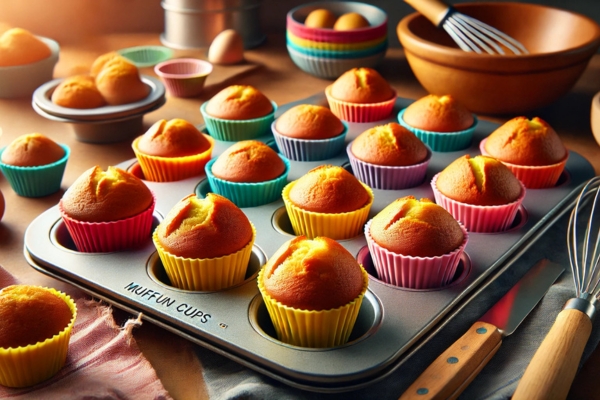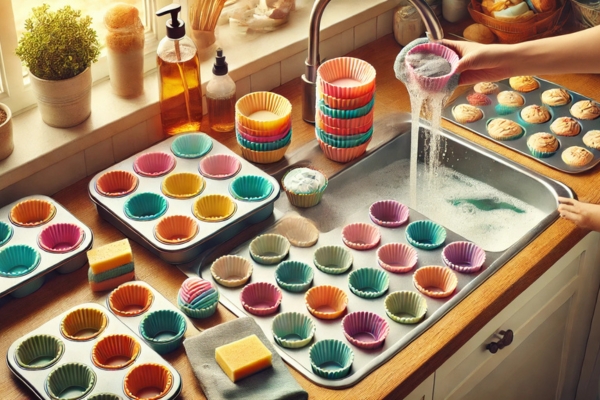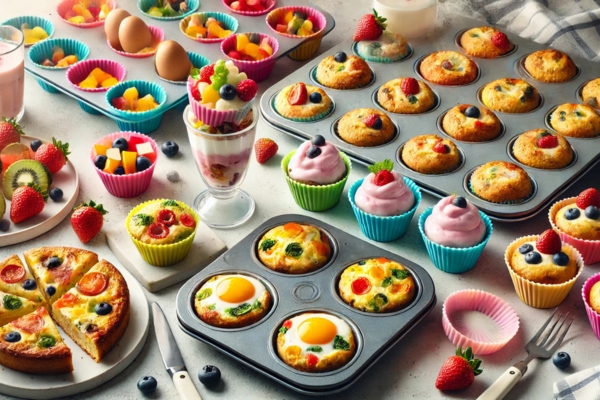Gone are the days of struggling with stubborn muffin liners or grimacing at the idea of scrubbing a dozen muffin tins. Silicone muffin cups have quickly gained recognition as one of the most essential tools in the modern kitchen, and for good reason. Whether you’re an amateur baker or a seasoned pastry chef, these flexible wonders can streamline your baking process while elevating the quality of your treats. From their non-stick surface to their eco-friendly design, silicone muffin cups redefine convenience and versatility.
These unsung heroes of the baking world make your culinary creations practically effortless. Picture this: perfect muffins sliding out of their cups with a satisfying ease, no messy paper to peel away. Add to that their reusable nature, saving you from the endless cycle of paper liner waste, and you have a baking tool that’s not just functional but environmentally conscious. Ready to dive in? This guide will walk you through everything you need to know about using, cleaning, and getting creative with it.
What Are Silicone Muffin Cups?
Imagine a baking tool that’s as resilient as it is flexible, capable of enduring both searing heat and freezing cold without losing its shape or functionality. Silicone cups are crafted from food-grade silicone, a synthetic rubber that can handle temperatures ranging from a frigid -40°F to a toasty 450°F. Unlike traditional metal muffin tins or paper liners, these cups boast an impressive durability and flexibility that make them both a practical and long-lasting addition to your kitchen arsenal.
Silicone’s key advantage lies in its non-stick properties. No more scraping off bits of batter from paper or greasing your tins before every bake. With silicone, your muffins, cupcakes, and other delights practically glide out of the cups, retaining their perfect form and structure. This magical material makes baking more efficient, mess-free, and, best of all, a breeze to clean. It’s no wonder cups are sweeping the kitchen world by storm.
How To Use Silicone Muffin Cups: The Basics
While silicone cups are incredibly user-friendly, understanding a few simple guidelines can help ensure your baked goods turn out just right.
Preparation: Before your first bake, give your silicone muffin cup a quick rinse with warm soapy water. This removes any dust or residue from the manufacturing process. Though silicone naturally has non-stick properties, a light brushing of oil or butter in each cup won’t hurt, especially for stickier bakes like muffins with fruit chunks.
Placing in a Pan: While silicone cups are highly flexible, it’s always wise to place them on a sturdy baking sheet or inside a muffin pan. This provides the structural integrity needed to prevent spillage and ensures uniform cooking. The flexibility of it means your cups can easily retain their shape while supporting their contents.
Filling the Cups: Pour your batter into each cup, but don’t overfill them. A filling of about two-thirds of the way is ideal. Silicone cups are designed to help your baked goods rise and form a lovely dome, but overfilling them may cause the batter to spill over. So, control the flow and let the silicone do its work.
Baking: Once your cups are filled, simply pop them in the oven. The heat circulates evenly around the flexible silicone, ensuring your treats bake uniformly. Depending on the recipe, you may notice slight variations in baking times compared to traditional muffin tins, so keep an eye on your creations. As always, check doneness with a toothpick before removing them from the oven.
Baking With Silicone Muffin Cup

Baking with muffin cups is an entirely new experience—one that will revolutionize how you view muffin tins. Unlike paper liners, which often leave a mess or cause your muffins to stick, silicone offers an effortlessly smooth release. With this material, muffins and cupcakes emerge perfectly intact, giving you flawless, golden results every time.
The even heat distribution of silicone is another advantage. Your muffins bake more consistently, eliminating the risk of hot spots that may lead to uneven cooking. Whether you’re making dense banana bread muffins or light, airy cupcakes, it ensures a golden, perfectly baked finish. However, always monitor baking times carefully, as silicone bakeware can sometimes affect how quickly the heat penetrates. A quick toothpick test will never fail you.
Cleaning And Storing Silicone Muffin Cups

One of the undeniable perks of muffin cups is their easy maintenance. Unlike metal tins, which rust or develop stains, silicone is inherently low-maintenance. A simple rinse with warm, soapy water will do the trick after each use. For even easier cleaning, most muffin cup are dishwasher-safe, though hand washing is recommended for keeping them in pristine condition for the long haul.
Over time, silicone may develop stubborn stains or odors. To keep your cups fresh, scrub them with a mixture of baking soda and water or soak them in vinegar and water. Both solutions are natural and highly effective for removing lingering scents and stains. After washing, let the cups air dry thoroughly to avoid any moisture that could affect their longevity.
As for storage, silicones flexibility means it’s incredibly easy to store these cups. You can stack them, fold them, or simply place them in a drawer without taking up excessive space. Just make sure to store them in a cool, dry place to protect the material from potential damage caused by sunlight or heat.
Creative Uses For Silicone Muffin Cups Beyond Muffins

Once you’ve enjoyed the ease of baking with a silicone muffin cup, it’s time to get creative. These versatile tools have much more potential than just holding muffin batter.
Egg Muffins: Whether you’re meal prepping or just looking for a quick breakfast, they are ideal for making baked eggs or egg muffins. Crack an egg into each cup, sprinkle in some vegetables, cheese, or herbs, and bake. You’ll have perfectly portioned, flavorful treats ready for the week ahead.
Frozen Treats: Silicone muffin cup are perfect for creating frozen treats like yogurt parfaits or individual ice cream cups. Simply pour in your desired ingredients, freeze them, and voilà—a no-fuss frozen snack that’s easy to pop out when you’re ready to enjoy.
Portion Control: Struggling with portion sizes? muffin cups help create individually sized servings for dishes like mini meatloafs, quiches, or even single-serve pizzas. Their uniform size and shape make them perfect for maintaining control over your portions.
The Advantages Of Silicone Muffin Cups Over Traditional Bakeware
What sets muffin cups apart from traditional bakeware? The benefits are clear.
- Non-stick Surface: Say goodbye to greasy sprays and the sticky aftermath of paper liners. Silicones non-stick properties ensure easy release every time.
- Durability: Unlike metal muffin tins that may rust or paper liners that are one-use-only, they are designed to last. They won’t warp or deteriorate over time, providing consistent results for years.
- Temperature Resistance: Silicone is a true champion when it comes to temperature extremes. Whether you’re baking, freezing, or even microwaving, silicones can handle it all.
- Eco-friendly: Since silicone is reusable, it drastically reduces waste compared to paper liners, making it an environmentally conscious choice.
Troubleshooting Common Issues With Muffin Cups
Though silicone muffin cup are generally easy to use, there are a few common issues that may arise:
- Muffins Sticking: If your baked goods are sticking, ensure you’re lightly greasing the cups or using a high-quality, non-stick silicones variety. Overfilling the cups can also lead to sticking, so be mindful of portion sizes.
- Unwanted Odors: Silicone is porous and may absorb odors over time. If you notice lingering smells, soak your cups in vinegar and water or use a baking soda paste to eliminate the odors.
- Warping: Silicone is heat-resistant, but it’s still important to follow the manufacturer’s guidelines regarding maximum temperature limits. Exceeding these limits may cause warping.
Is It Worth Switching To Silicone Muffin Cup?
For those seeking a more durable, eco-friendly, and versatile option in their kitchen, silicone muffin cup are undoubtedly worth the switch. They offer everything you love about traditional muffin tins—plus a whole lot more. With their non-stick surface, easy cleanup, and ability to withstand both high and low temperatures, muffin cups offer unparalleled convenience and reliability. Once you get the hang of using them, you’ll wonder why you ever used anything else.
FAQs About How To Use Silicone Muffin Cups
Do Silicone Muffin Cup Work For Gluten-Free Baking?
Absolutely! Silicones cups are golden for gluten-free baking. Why? Because they’re non-stick! Gluten-free batters can be a bit more temperamental, sometimes sticking or crumbling, but not with silicone! Just a light grease, and your muffins will slide out like a dream, all fluffy and intact. Pro tip: if your batter’s particularly dense, grease them lightly for that flawless, no-stick magic.
Can Silicone Muffin Cup Be Used In The Freezer?
You bet! Muffin cups are true multi-taskers. Stick them in the freezer, and they won’t crack, warp, or throw a fit. Whether you’re freezing homemade ice cream, prepping mini quiches, or making little frozen yogurt bites, these cups have got your back. The flexibility makes popping out frozen treats a breeze—goodbye to that dreaded “frozen food stuck to the mold” moment!
Are Silicones Muffin Cup Dishwashers Safe?
Most Huffin cups are dishwasher safe, yes! However, if you want to keep them in tip-top shape for years to come (and let’s face it, you want that), handwashing with a mild dish soap and a soft sponge is your best bet. A quick wash and they’re good to go, ready to rock your next muffin-making adventure.
When Baking Cupcakes With Paper Cups?
Paper muffin cups have their moment, especially if you’re making a lot of cupcakes at once—say for a party or event. They’re great for single-use situations. But for everyday baking, muffin cups are the way to go. They’ll save you time, money, and an endless cycle of tossing away paper liners. Plus, they won’t leave you scrambling for that last-minute paper cup when you’re in the middle of mixing your batter.
Conclusion
Are silicone muffin cups worth the hype? Oh, they sure are. They offer a mix of convenience, durability, and eco-friendliness that’s hard to beat. Whether you’re baking, freezing, or even crafting creative treats, they’re the ultimate game-changer in your kitchen. So, if you’re tired of the mess and waste of disposable liners (and who isn’t?), it’s time to make the switch. Once you get the hang of them, you won’t be able to imagine your kitchen without these versatile, non-stick wonders. Your muffins, and your eco-conscious heart, will thank you!